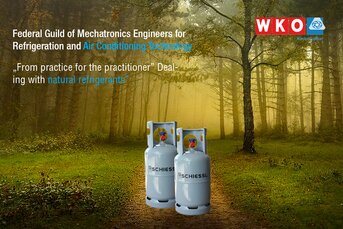- Using alternative refrigerant products


Use of alternative refrigerants for the conversion or new design of refrigeration systems
The phase down for the CO2 equivalent quota which is embedded in the current F-Gas Regulation already reveals significant changes in the prices and availability of the HFC refrigerants used to date. The service ban for systems with refrigerants with a GWP > 2500 and a load with a CO2 equivalent of more than 40t and the usage ban of refrigerants with a GWP > 2500 for stationary new systems is also moving closer and closer (from 01.01.2020). Below you will find some info on possible alternatives with chemical low GWP refrigerants in relation to the conversion of systems or new design.
Alternatives to R404A/R507A
New installations deep-freezing
R448A/R449A can be used as refrigerants for new systems in the deep-freezing sector. Both substances have higher compression end temperatures and therefore the application limits must be carefully taken into account when selecting compressors. Because of their design, semi-hermetic reciprocating compressors or suitable scroll compressors are recommended depending on the use and temperatures, possibly with appropriate additional cooling.
The refrigerant R452A is a possible alternative for smaller systems with fully hermetic compressors. This refrigerant has significantly lower compression end temperatures than R448A/R449A, allowing the use of fully hermetic compressors. These refrigerants can also be used for normal cooling in principle, but due to their composition they have a relatively large glide, higher pressures and the problem of segregation in case of leakage.
Normal cooling new installations
We do not necessarily recommend these substances for use with normal cooling in new systems. In this case it is advisable to resort to R134a and its substitutes, which are mentioned below.
Existing systems - repairs/conversions
R448A/R449A are suitable as substitutes for R404A/R507A for converting existing refrigeration and freezer systems. In this case, however, it must be checked carefully whether the application window of the existing compressor allows this and whether any additional cooling measures are necessary.
The conversion to the two new refrigerants can also be expected to result in a reduction in performance compared to R404A and R507A. The reduction in performance increases as the evaporating temperature falls. However, the performance figures of the systems are improving slightly. The mass flow of the refrigerant decreases with R448A/R449A and therefore especially the injection valves, control valves
and solenoid valves have to be checked for their size and functionality and possibly exchanged for smaller components or the setting has to be adjusted.
For use in refrigeration systems in combination with existing fully hermetic compressors (excluding suitable scroll compressors for deep-freeze operation with additional refrigerant injection), these two substitute refrigerants are not suitable due to the higher compression end temperatures.
R452A is especially suited for deep freezing systems with fully hermetic compressors. The compression end temperatures is very similar to R404A/R507A. R452A has a practically identical mass flow and the necessary adjustments are therefore minimal. This refrigerant is also subject to reduced performances and must be taken into account.
Why not always use R452A?
R448A and R449A have significantly lower GWP values than R452A and should therefore be used in any case if technically possible.
Important: When refrigerant is lost on an R404A or R507A system, none of these new Low GWP refrigerants can be simply topped up. The remaining R404A/R507A must be completely extracted and disposed of or recycled. Only then may the alternative refrigerant be introduced!
There should be no problems with regard to the refrigerating machine oil present, since normally the existing polyolester oils can be used here. The condition of the oil should be checked nevertheless and the oil changed if necessary. The intervals for an oil change may also be shorter during operation, since the oil is subject to greater wear due to
higher compression end temperatures. The drier must be replaced every time the refrigeration circuit is changed. Some of the substitutes have a lower practical limit value. A check must be made to ascertain whether the
maximum permissible filling quantity for the existing installation is not exceeded during a conversion, or whether the supply and exhaust air flow in the machine area may have to be increased accordingly, for example.
Alternatives to R134a
R134a is available for the near future (but with increasing prices) and is also not subject to the problem of service bans. However, substitute refrigerants such as R513A and R450A are already available.
New systems
The benefits of these two refrigerants compared to R448A, R449A and R452A are obvious in normal refrigeration applications: Lower pressures, very small glide and a GWP that is practically halved. Many component manufacturers have already published the relevant data.
Repairs/conversions of existing systems
Of course, it may be the case that systems are to be converted from R134a to R513A or R450A (for example, to extend the test cycles of the system in relation to the leakage test). This should not be a major problem with regard to the existing compressors, although in some cases the official approvals of the manufacturers are still missing. A reduction in performance with the new substances can also be assumed here and in this case the new refrigerant must not be mixed with R134a either. The quality of the oil present must also be checked at this point and,
if necessary, the oil should be changed and the driers replaced when the system is accessed. When it comes to glide, these alternative refrigerants are cheaper - they have no glide or a negligible,
small glide.
The mass flow rate will be somewhat higher in this case, which means that the size and setting of injection valves, control valves and solenoid valves must also be checked - whether they are large enough or whether they may need to be increased. The problem with the practical limit value is not raised here, since the limit values are somewhat higher than those of R134a.
Component selection
Many design programs already contain the refrigerants specified and allow easy selection of the required components. In terms of compatibility with metallic materials and sealants, there are usually no problems in comparison with R134a or R404A. Nevertheless, it should be taken into consideration whether the manufacturer of the components for the new refrigerants has issued a release. The lubricants that are used are normally the same POE oils that are used for HFC refrigerants. Special attention must be paid to the application limits when selecting a compressor. The selection programs and the corresponding information brochures from the compressor manufacturers provide the necessary information here. The glide should always be taken into account when selecting the heat
exchanger.




